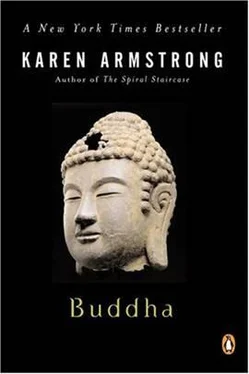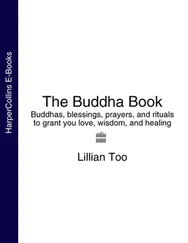We do not know when the yogic exercises were first evolved in India. There is evidence that some form of yoga might have been practiced in the subcontinent before the invasion of the Aryan tribes. Seals have been found dating from the second millennium b.c.e. which show people sitting in what might be a yogic position. There is no written account of yoga until long after Gotama’s lifetime. The classical texts were composed in the second or third century c.e. and based on the teachings of a mystic called Patanjali, who lived in the second century b.c.e. Patanjali’s methods of contemplation and concentration were based on the philosophy of Samkhya but started at the point where Samkhya breaks off. His aim was not to propound a metaphysical theory but to cultivate a different mode of consciousness which can truly enter into truths which lie beyond the reach of the senses. This involves the suppression of normal consciousness, by means of exacting psychological and physiological techniques which give the yogin insights that are suprasensory and extrarational. Like Alara Kalama, Patanjali knew that ordinary speculation and meditation could not liberate the Self from praktri: the yogin had to achieve this by sheer force. He had to abolish his ordinary ways of perceiving reality, cancel out his normal thought processes, get rid of his mundane (lower-case) self, and, as it were, bludgeon his unwilling, recalcitrant mind to a state that lay beyond the reach of error and illusion. Again, there was nothing supernatural about yoga. Patanjali believed that the yogin was simply exploiting his natural psychological and mental capacities. Even though Patanjali was teaching long after the Buddha’s death, it seems clear that the practice of yoga, often linked with Samkhya, was well established in the Ganges region during Gotama’s lifetime and was popular among the forest-monks. Yoga proved to be crucial to Gotama’s enlightenment and he would adapt its traditional disciplines to develop his own dhamma. It is, therefore, important to understand the traditional yogic methods, which Gotama probably learned from Alara Kalama and which put him onto the road to Nibbana.
The word “yoga” derives from the verb yuj: “to yoke” or “to bind together.” Its goal was to link the mind of the yogin with his Self and to tether all the powers and impulses of the mind, so that consciousness becomes unified in a way that is normally impossible for human beings. Our minds are easily distracted. It is often hard to concentrate on one thing for a long time. Thoughts and fantasies seem to rise unbidden to the surface of the mind, even at the most inappropriate moments. We appear to have little control over these unconscious impulses. A great deal of our mental activity is automatic: one image summons up another, forged together by associations that have long been forgotten and have retreated into oblivion. We rarely consider an object or an idea as it is in itself, because it comes saturated with personal associations that immediately distort it and make it impossible for us to consider it objectively. Some of these psychomental processes are filled with pain: they are characterized by ignorance, egotism, passion, disgust and an instinct for self-preservation. They are powerful because they are rooted in the subconscious activities ( vasanas ) that are difficult to control but that have a profound effect on our behavior. Long before Freud and Jung developed modern psychoanalysis, the yogins of India had discovered the unconscious mind and had, to a degree, learned to master it. Yoga was thus deeply in line with the Axial Age ethos-its attempt to make human beings more fully conscious of themselves and bring what had only been dimly intuited into the clear light of day. It enabled the practitioner to recognize these unruly vasanas and get rid of them, if they impeded his spiritual progress. This was a difficult process, and the yogin needed careful supervision at each step of the way by a teacher, just as the modern analysand needs the support of his or her analyst. To achieve this control of the unconscious, the yogin had to break all ties with the normal world. First, like any monk, he had to “Go Forth,” leaving society behind. Then he had to undergo an exacting regimen which took him, step by step, beyond ordinary behavior-patterns and habits of mind. He would, as it were, put his old self to death and, it was hoped, thus awaken his true Self, an entirely different mode of being.
All this will sound strange to some Western people who have had a very different experience of yoga. The sages and prophets of the Axial Age were gradually realizing that egotism was the greatest hindrance to an experience of the absolute and sacred reality they sought. A man or a woman had to lay aside the selfishness that seems so endemic to our humanity if he or she wished to apprehend the reality of God, brahman or Nibbana. The Chinese philosophers taught that people must submit their desires and behavior to the essential rhythms of life if they wanted to achieve enlightenment. The Hebrew prophets spoke of submission to the will of God. Later, Jesus would tell his disciples that the spiritual quest demanded a death to self: a grain of wheat had to fall into the ground and die before it attained its full potential and bore fruit. Muhammad would preach the importance of islam , an existential surrender of the entire being to God. The abandonment of selfishness and egotism would, as we shall see, become the linchpin of Gotama’s own dhamma, but the yogins of India had already appreciated the importance of this. Yoga can be described as the systematic dismantling of the egotism which distorts our view of the world and impedes our spiritual progress. Those who practice yoga in America and Europe today do not always have this objective. They often use the disciplines of yoga to improve their health. These exercises of concentration have been found to help people to relax or suppress excessive anxiety. Sometimes the techniques of visualization used by yogins to achieve spiritual ecstasy are employed by cancer sufferers: they try to imagine the diseased cells and to evoke subconscious forces to combat the progress of the illness. Certainly, the yogic exercises can enhance our control and induce a serenity if properly practiced, but the original yogins did not embark on this path in order to feel better and to live a more normal life. They wanted to abolish normality and wipe out their mundane selves.
Many of the monks of the Ganges plain had realized, as Gotama did, that they could not achieve the liberation they sought by contemplating a dhamma in a logical, discursive way. This rational manner of thinking employed only a small part of the mind, which, once they tried to focus exclusively on spiritual matters, proved to have an anarchic life of its own. They found that they were constantly struggling with a host of distractions and unhelpful associations that invaded their consciousness, however hard they tried to concentrate. Once they began to put the teachings of a dhamma into practice, they also discovered all kinds of resistance within themselves which seemed beyond their control. Some buried part of themselves still longed for forbidden things, however great their willpower. It seemed that there were latent tendencies in the psyche which fought perversely against enlightenment, forces which the Buddhist texts personify in the figure of Mara. Often these subconscious impulses were the result of past conditioning, implanted within the monks before they had attained the age of reason, or part of their genetic inheritance. The Ganges monks did not talk about genes, of course; they attributed this resistance to bad kamma in a previous life. But how could they get past this conditioning to the absolute Self, which, they were convinced, lay beyond this mental turmoil? How could they rescue the Self from this frenzied praktri ?
Читать дальше












